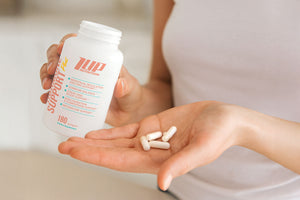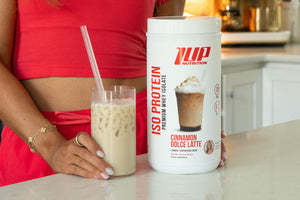Summer is here, and for many of you planning on entering our summer transformation challenge (registration starts July 7th), that means it’s time to start cutting.
As you’re likely aware, the key to any successful weight loss venture is nutrition.
With that in mind, we’ve gathered a list of 10 of our favorite summer foods to help weight loss.
Now, don’t get the impression that these foods are somehow “magical” or will induce rapid weight loss when eaten. No food will do that, and anyone who tells you that a certain food will make the pounds fly off of your body is disingenuous.
These foods though are delicious and rich in vitamins, minerals, water, and fiber and can easily fit into any weight loss diet.
Let’s get to the food!
Top 10 Summer Foods for Weight Loss
#1 Berries
If there were such things as “superfoods”, berries would easily qualify. These nutritional powerhouses are loaded with essential vitamins and minerals as well as antioxidants and polyphenols that support cardiovascular health and combat oxidative stress.[1]
Berries are also rich in fiber and water, both of which help you feel full. And, perhaps best of all, berries are very low in calories for the nutritional punch they offer...a typical serving of berries contains between 50-80 calories.
Don’t limit yourself to just strawberries or blueberries, give raspberries, blackberries, and cranberries a shot too!
#2 Peaches
Another one of the great summertime fruits is the humble peach.
The average peach contains a mere 39 calories but delivers high amounts of vitamin C and potassium.
Peaches are also rich in beta-carotene, a carotenoid that is also found in carrots that give peaches (and carrots) their golden hue. Beta-carotene also serves as a precursor to vitamin A, an essential vitamin that supports eye health.
#3 Tomatoes
Often considered a vegetable, but a fruit, tomatoes are a food that are extremely versatile and makes for a perfect fit in any diet, be it muscle building or fat loss oriented.
A medium tomato contains ~30 calories, including 2 grams of fiber.
Tomatoes are rich in several micronutrients, including vitamin C and potassium. They also come packed with lycopene, an antioxidant that helps protect against UV-ray damage.
Note: cooking tomatoes actually increases their lycopene content[3]
Some of our favorite ways to use tomatoes are:
- In a fresh salsa with chopped onions, jalapenos, and cilantro
- As the base of a delicious marinara sauce
- Drizzled with a bit of olive oil and garnished with fresh mozzarella and basil
#4 Zucchini / Summer Squash
These delectable vegetables (“fruits” if we’re going by botanical classifications) are ripe for the picking in summer and they’re the perfect addition to a summer cook-out filled with all sorts of lean grilled meats.
Zucchini, and their little brother (the yellow summer squash), are mild in flavor, yet slightly sweet, and can adapt to just about any flavor combo you pair them with, which makes them incredibly versatile.
As we already mentioned, they make a fine grilled side dish during backyard BBQs, and they can also be roasted, baked, sauteed, steamed, or shredded and used in salads or a baked sweet treat like zucchini bread.
One serving of zucchini (150g) contains a paltry 17 calories and 3 grams of carbohydrates but contains generous amounts of vitamins A & C as well as the essential electrolytes potassium and calcium.
#5 Watermelon
The quintessential summer snack, no list for the best summer foods for weight loss would be complete without watermelon.
As the name implies, watermelons are chock full of water. In fact, watermelons are ~92% water by mass.
What this means is that they can help fill you up, but don’t take a huge chunk out of your daily calorie allowance while dieting.
Watermelons, similar to tomatoes, are rich in powerful antioxidants like lycopene and vitamin C. And, due to their high water content, watermelon also helps you stay hydrated while you’re out having fun in the sun!
#6 Pineapple
This tropical treat is sweet and indulgent, yet incredibly healthy as it’s packed with fiber, micronutrients, and water.
Pineapple is delicious on its own, in a salad, or sliced into planks or rings and grilled.
As a bonus, pineapple contains the enzyme bromelain, which has been noted in research to help reduce inflammation and nasal swelling as well as support wound healing.[4]
Animal studies also suggest that pineapple juice may help reduce the fat formation and increase fat breakdown.[5]
#7 Peas
For those looking to increase their protein intake, yet not necessarily increase their consumption of animal products, peas offer a great option.
These tasty green spheres are rich in protein and iron, yet low in saturated fat and calories (the same of which can’t be said for red meat).
#8 Peppers
Be it sweet or spicy, peppers are one of the summer’s most delicious and versatile foods.
They can be eaten fresh, sliced up and put into salads or used as a dipper in salsa, hummus, or a yogurt-based ranch dressing.
Peppers can also be grilled, roasted, or stuffed with a combination of grains and protein to complement their lean-body benefits.
Let’s not forget that peppers also contain capsaicin -- a fiery alkaloid that gives peppers their tongue-tingling quality and also helps reduce appetite while boosting metabolism.[6,7]
#9 Cucumbers
Cucumbers are packed with water and potassium -- an essential electrolyte that helps regulate the amount of sodium retained by the kidneys.
They’re also low in calories, containing a mere 16 calories per cup.
Cucumbers are enjoyable on their own, added to soups, salads, smoothies, or as a garnish for infused-waters.
To top it off, this delicious summertime food also contains compounds that offer antioxidant and anti-inflammatory benefits.[8]
#10 Grilled Kebabs
Cookouts are a mainstay of summertime. And, many of the foods commonly cooked at these grill fests are perfectly in accordance with a weight loss diet.
One of our absolute favorites is grilled kebabs.
Simply thread some lean proteins and vegetables into skewers and grill for 3-5 minutes per side for the ultimate quick-fix, flat belly meal.
To make cooking a bit easier (and stop cross contamination of raw meat touching raw vegetables), place your cubed meat on one skewer and put your veggies on another.
References
- Basu A, Rhone M, Lyons TJ. Berries: emerging impact on cardiovascular health. Nutr Rev. 2010;68(3):168-177. doi:10.1111/j.1753-4887.2010.00273.x
- Olas B. Berry Phenolic Antioxidants - Implications for Human Health?. Front Pharmacol. 2018;9:78. Published 2018 Mar 26. doi:10.3389/fphar.2018.00078
- Cooking tomatoes boosts disease-fighting power. (2020, 18). ScienceDaily.https://www.sciencedaily.com/releases/2002/04/020422073341.htm
- Bromelain. (n.d.). NCCIH. https://www.nccih.nih.gov/health/bromelain
- El-Shazly SA, Ahmed MM, Al-Harbi MS, Alkafafy ME, El-Sawy HB, Amer SAM. Physiological and molecular study on the anti-obesity effects of pineapple (Ananas comosus) juice in male Wistar rat. Food Sci Biotechnol. 2018;27(5):1429-1438. Published 2018 Apr 11. doi:10.1007/s10068-018-0378-1
- Reinbach HC, Smeets A, Martinussen T, Møller P, Westerterp-Plantenga MS. Effects of capsaicin, green tea and CH-19 sweet pepper on appetite and energy intake in humans in negative and positive energy balance. Clin Nutr. 2009;28(3):260-265. doi:10.1016/j.clnu.2009.01.010
- Zheng J, Zheng S, Feng Q, Zhang Q, Xiao X. Dietary capsaicin and its anti-obesity potency: from mechanism to clinical implications. Biosci Rep. 2017;37(3):BSR20170286. Published 2017 May 11. doi:10.1042/BSR20170286
- Ji L, Gao W, Wei J, Pu L, Yang J, Guo C. In Vivo Antioxidant Properties of Lotus Root and Cucumber: A Pilot Comparative Study in Aged Subjects. J Nutr Health Aging. 2015;19(7):765-770. doi:10.1007/s12603-015-0524-x






